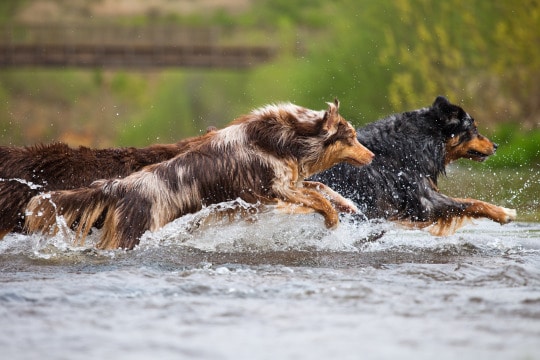The new guy — fitting in with your other pups…

So, you have got a couple of lovely dogs who get on really well together. You’ve got plenty of room so why not get another dog? It seems a great idea. Off you go to the local rescue centre and find the perfect addition to your little band of fur balls. You go through the checks including introducing your pups to the new one at the centre. Everything goes fine, the perfect match!
For the first few days, everything seems OK, the new dog seems to be fitting in well. Then, for no apparent reason, things start to go wrong. The new dog has started to become aggressive with one of the others but, not the other one. He is baring his teeth and looks like he wants to fight with the other dog. You are struggling to understand this. The rescue centre said there where no behavioural problems with the new dog. In fact, they said she got on well with other dogs and was a bit of a cutie.
This is not an uncommon problem. So, what is going on? The first thing to understand is this is nothing to do with lack of socialisation. This is more likely to do status. Dogs are similar to wolves when in groups — there is a strict hierarchy and deference shown to pack members. The new dog may be challenging the status of the other dog it is showing aggression to. Interdog aggression (as demonstrated here) is not common in households with more than one dog. In these situations is is more likely to occur between dogs of the same sex. Often seen in females, but it can happen with males (particularly un-castrated ones).
This is a difficult and dangerous problem. If, for instance, the dog that is the object of the aggression is totally submissive it is entirely possible that the aggressor will move in to kill the other dog. This may sound over dramatic but this can be the case. This is a problem that needs dealing with quickly.
Observing the behaviour of the dogs will help you to understand what is going on. You will see that the aggressor challenges the targeted dog. these challenges may be active such as those over food, toys or seeking attention from the owners — if the challenged dog backs down, the situation usually resolves. Passive aggression involves posturing and staring, for instance. If the other dog does not back down, aggression ensues. Other behaviours may include pushing the targeted dog out the way when going through doors, claiming the other dogs sleeping area and taking the other dogs food, for instance. You get the picture.
In fact, conflict and aggression can result in any context involving deference and hierarchy. Interdog aggression usually becomes apparent when a dog reaches maturity (18 to 24 months old) therefore, it is not uncommon for someone to have two dogs living happily together and then, when one of them reaches maturity, all hell breaks loose.
What to do? First things first. If the dog is female, get it neutered — this will reduce hormonal fluctuations that can be contributing to the problem. If the problem dog is male, get it castrated. A castrated male tends to be calmer and less reactive.
It would be wrong of me to go into too much detail on how to deal with this problem from a behavioural perspective. This will need you to seek help from a ‘qualified’ canine behaviourist. The aim in this situation is to establish a pack order — to do this your behaviourist will consider quite a few factors.
The bottom line is that the aggressor or the targeted dog, depending on the circumstances will need to be reinforced as the, if you like, senior dog in the pack. This means, for instance, it gets fed first, it gets played with first, it get preferential treatment for most things. This will establish it as the top dog, the other dog/s will learn to accept this. It sounds very straightforward. It is, only if the right protocols are put into place and ALL the humans in the household adhere to them.
So, don’t despair, this is not an insurmountable problem. It does, however, require professional help. If you have this problem — don’t give up and good luck.
